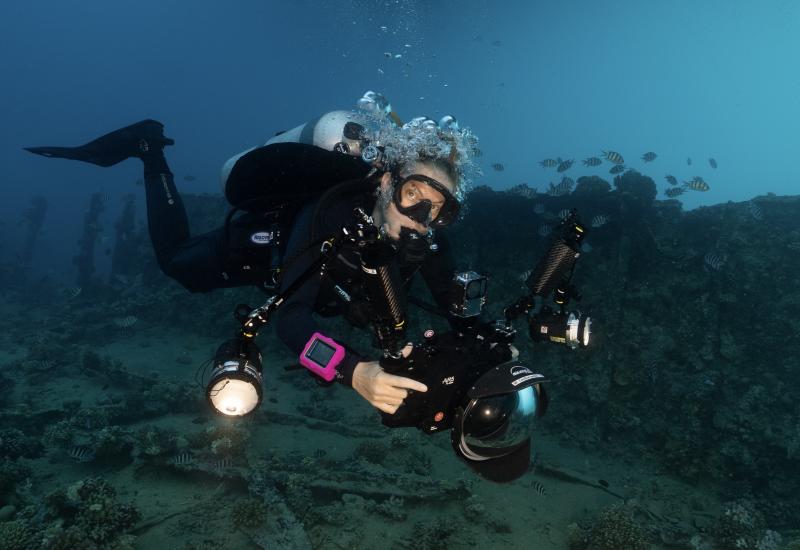Shrimp in the Spotlight: Making Crustacean Photo Magic

Alex MustardGear Nikon D4 with 105mm lens
Settings f/32; 1/250; ISO 200
If there is a spider in the bathtub, you will find me waiting outside the door while my wife captures it. But put me underwater, and I’ll spend hours seeking out close-up encounters with 10-legged arthropods! Shrimps are a photographic addiction for many, and fortunately, they are common in both cool and tropical waters, and come in a great diversity of forms and striking colors.
You can shoot the intricately patterned marbled shrimps or aim your lens at the numerous cleaning shrimps with showy stripes or antennae, or strangely shaped species such as the sawblade and Donald Duck shrimps. And of course, both pelagic species and larval-stage shrimps are star attractions on blackwater dives.
However, despite there being so many shrimps to shoot, they are not always as beautiful in photos as they are in life. Frozen in a still image, their complex shape blends in with the background. Shrimps are decapods, with 10 walking legs and a host of other appendages, including a similar number of swimming legs beneath their abdomen and then a gaggle of antennae sticking out the front. The upshot is that shrimps are messy, and to produce compelling images, you have to be as tidy as possible photographically, or they will get mixed up with their surroundings.
Related Reading: How This Award-winning Underwater Photographer Got His Start by Volunteering
When I spot a shrimp, I use several techniques to make the subject stand out. The simplest is to search for a shrimp sitting up on top of the reef so that you can frame it against open water. This ensures it stands out against a clean black background. However, unless you are blackwater diving, you’re unlikely to find one. Shrimps have many predators, so they rarely expose themselves naturally. Instead, the onus is on you to use selective lighting to isolate them from their surroundings. A snoot is ideal for this. If you still have a snoot phobia, you can use lighting techniques, such as inward lighting or backlighting, to high- light the shrimp and make it stand out from the background.
Many shrimps live on or with specific creatures, such as those that benefit from the protection of a stinging anemone, or hitchhike on a well-protected critter like a spiky urchin or noxious nudibranch. If you compose carefully, the natural symmetry or repeating patterns in the host species can provide a graphically interesting backdrop. These shots are most effective when taken with maximum depth of field and when the shrimp is framed relatively small and off-center in the picture.
Since most shrimps are small, another method of simplifying their busy bodies is to shoot super macro. As photographic magnification rises, the depth of field falls and blurs out all the messiness of the subject. It remains crucial to keep the eyes in focus, but with many shrimps, blurring out the rest of those appendages makes the image pop. I prefer to use a fixed focus for these shots, carefully rocking the camera forward and back until the eyes are razor sharp.
It is well worth studying your shrimps so you know where to find the eyes. A photographer I dive with once came up from shooting harlequin shrimps, rejoicing that he got the eyes pin sharp, and in fact had photos of the sharpest antennae I had ever seen!

Alex MustardGear Nikon D5 with 105mm lens
Settings f/29; 1/250; ISO 200
Behind The Shot
1 Commensal shrimps live on other species that provide naturally pleasing backgrounds. With larger hosts, trying to photograph the whole animal will leave the shrimp too small, so instead I prefer to entirely fi ll the frame with the patterns of the host and then frame the shrimp against it. One of the most photogenic commensals is the emperor shrimp that comes in several color patterns and lives on lots of different species. Since the background, here a sea cucumber, naturally shows off the shrimp, I used a closed aperture to maximize depth of field in the scene.
2 With so many walking and swimming legs, shrimps are complicated animals, so you need to photograph them in simple ways to let their natural beauty shine through. Here, I used a single strobe fitted with a snoot to light the subject and the small piece of starfish it was guarding. Harlequin shrimps are arguably the most beautiful shrimp, but they are also predators, capturing and feeding on starfish. Since the lighting was isolating the subject, I closed the aperture to maximize the depth of field and used a low ISO and fast shutter speed to quench any ambient light.
Related Reading: The Best of Bimini: Where to Stay on this Dual-Island Destination
Where To See Them
Shrimps are spread throughout the oceans in both warm and cold water and can even be found in freshwater habitats. Southeast Asia has the highest diversity of shrimp species, and the charming island of Bali in Indonesia is a perfect place to search.
Bali is one of the most reliable places to see both the beautiful harlequin and Coleman shrimps. The best diving in Bali is along the north coast, around the small town of Tulamben.
Finally, if you are into shrimps it pays to dive at night. Far more shrimps are out and about at night, when they are much less likely to become fish food. Use a redbeamed dive light rather than whitebeamed light when photographing them, as it is much less likely to have them scurrying for safety.










